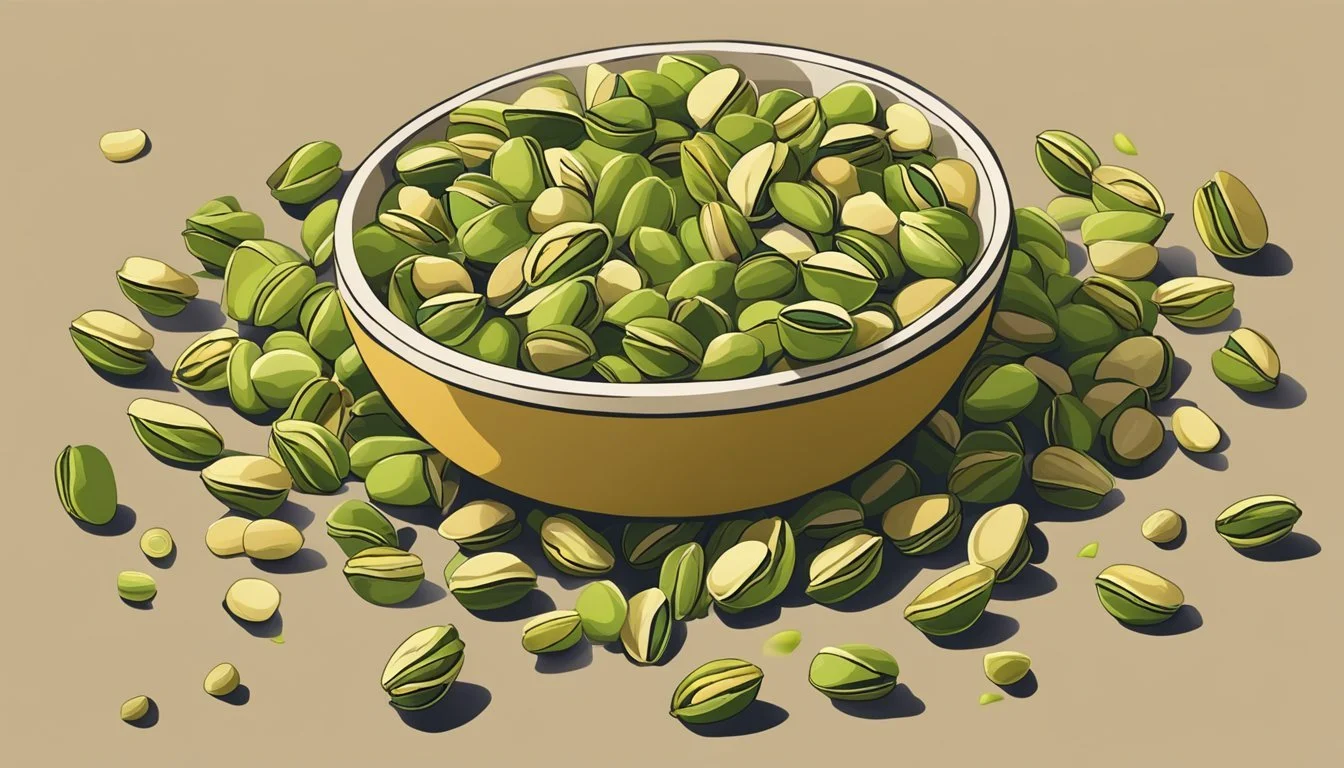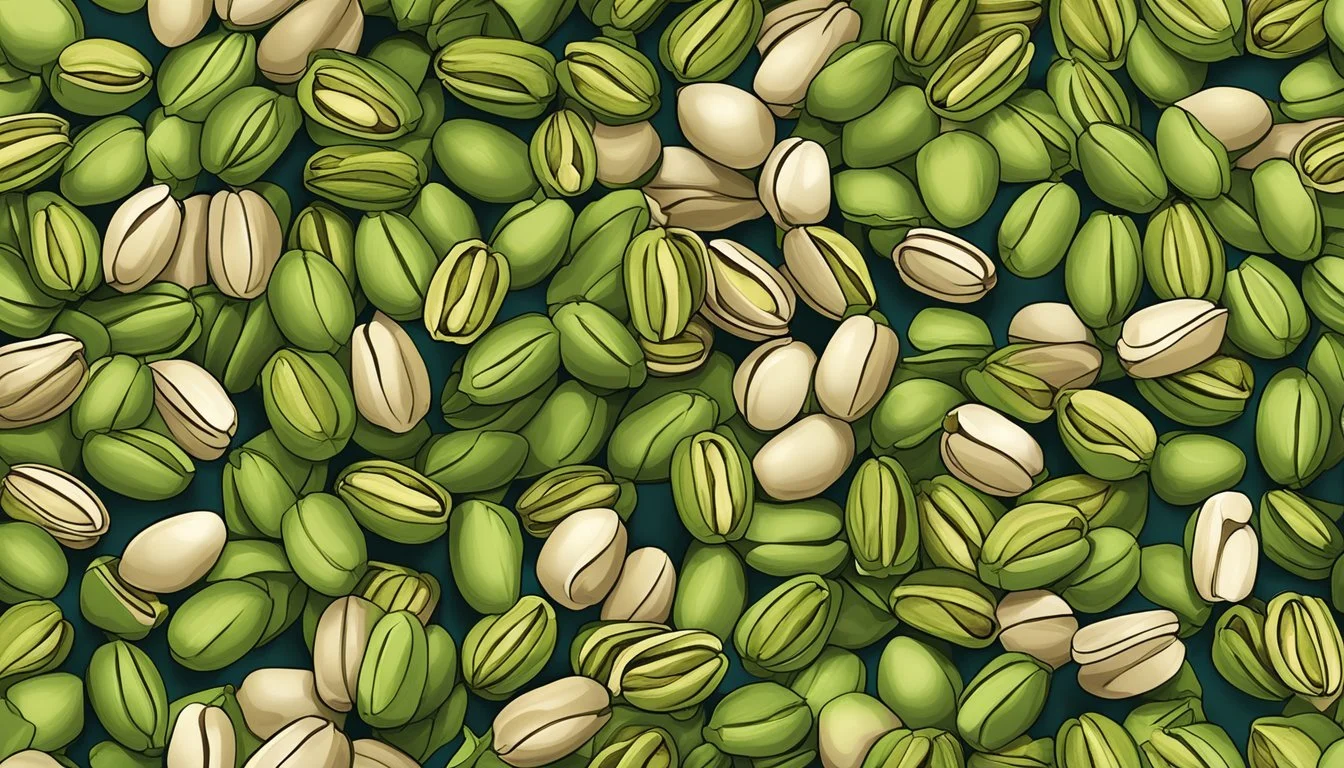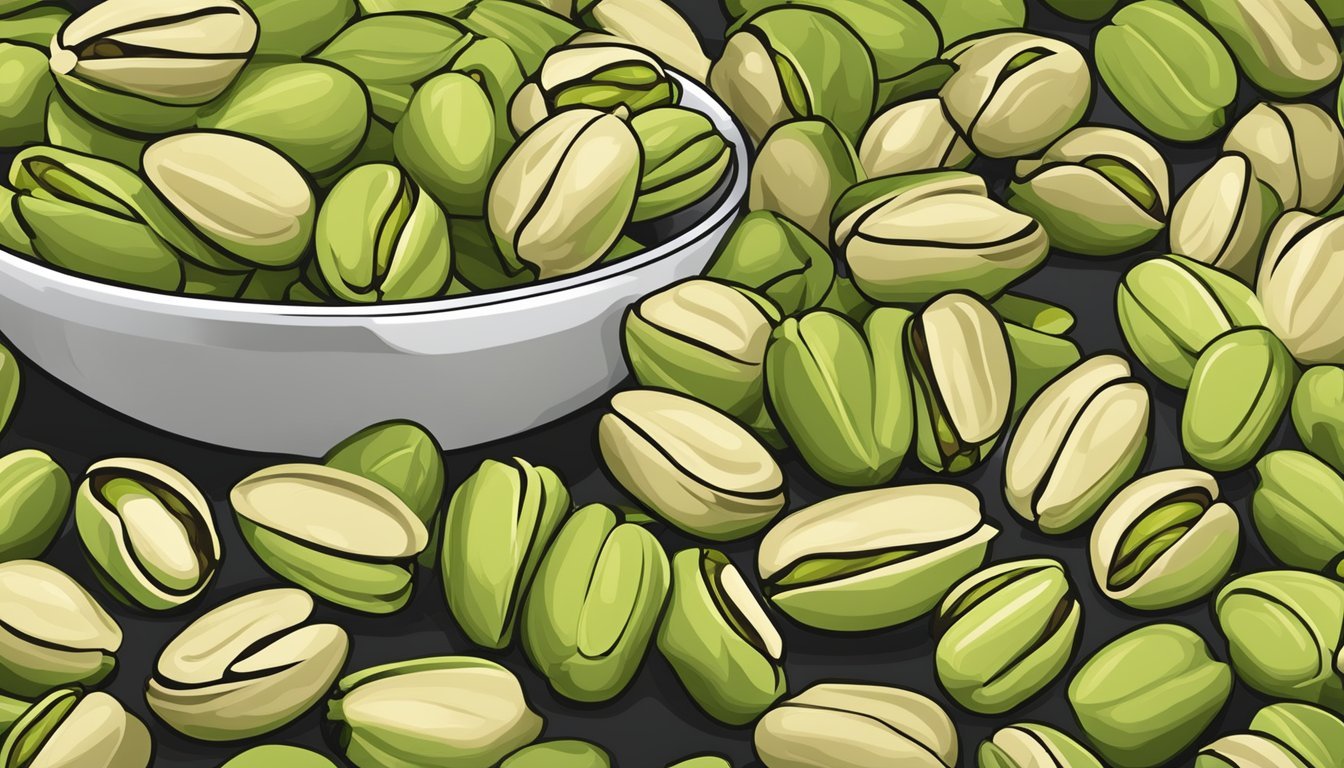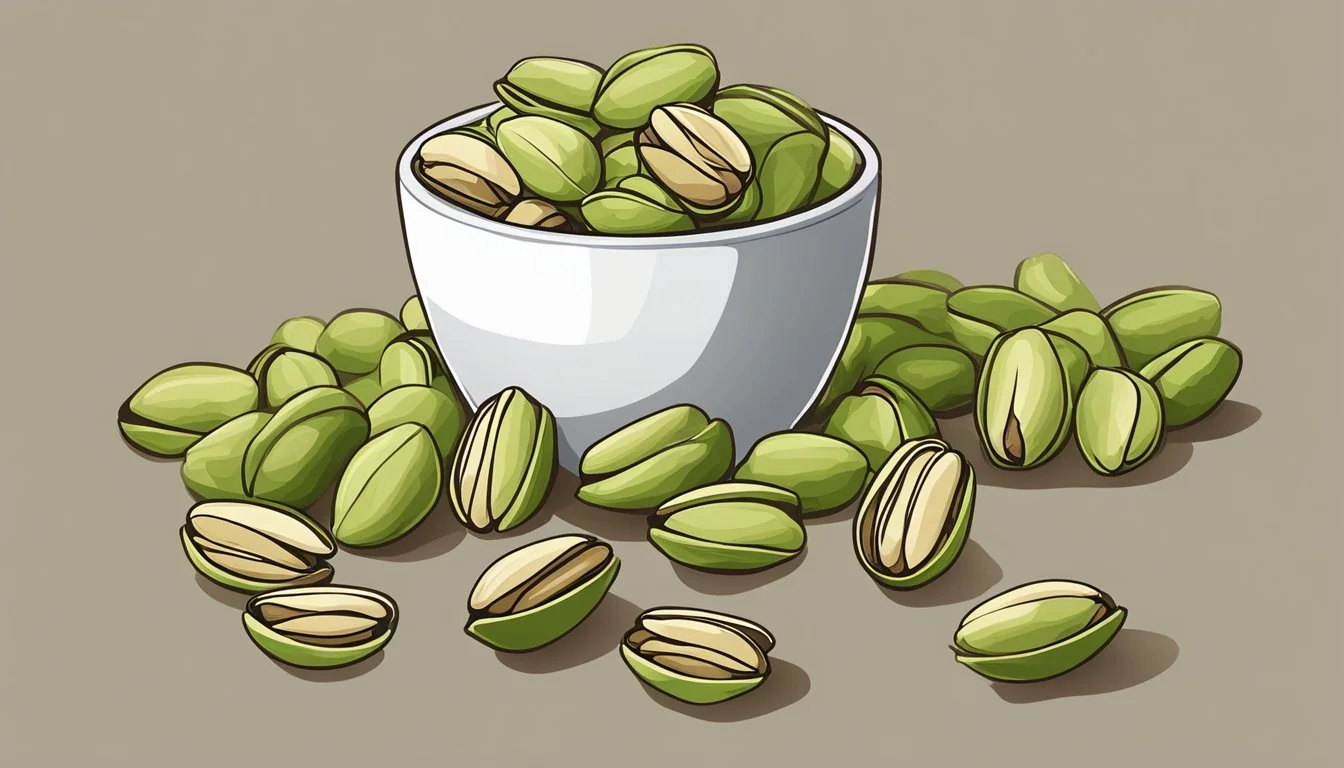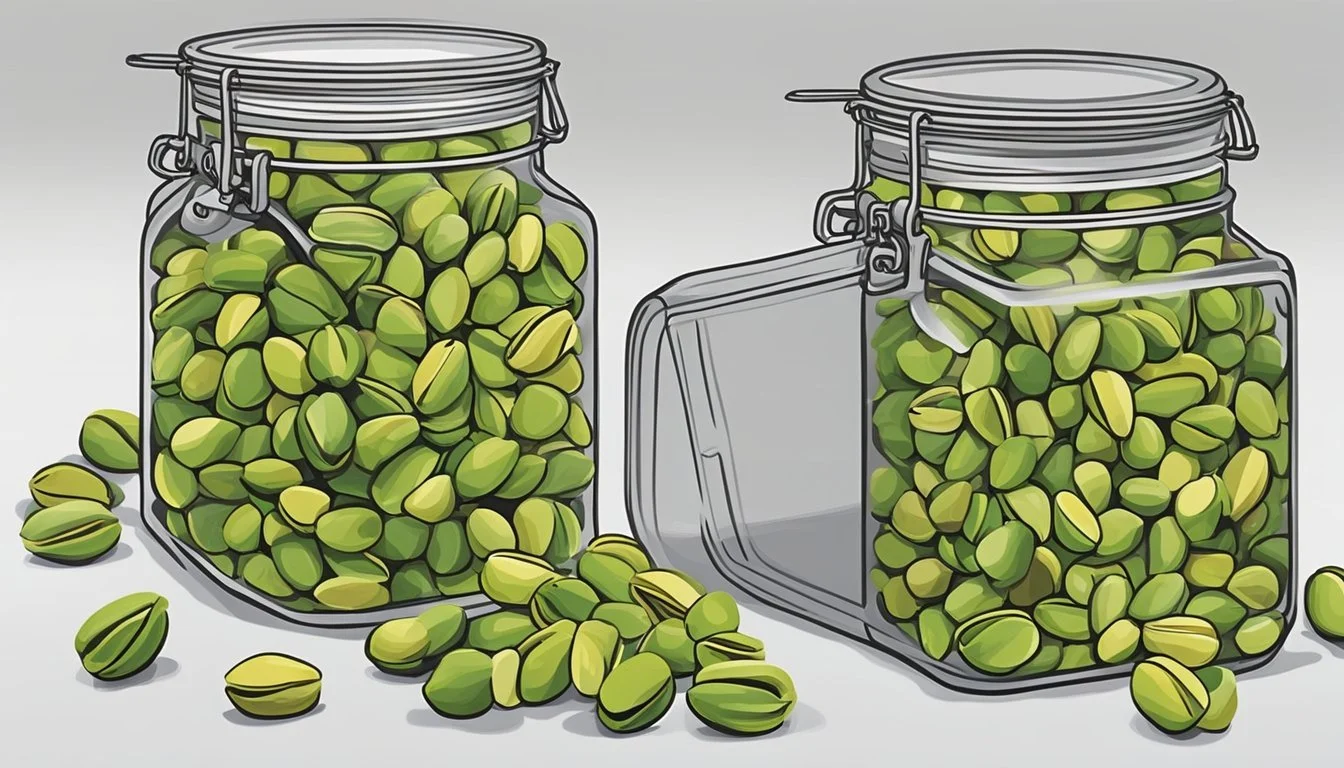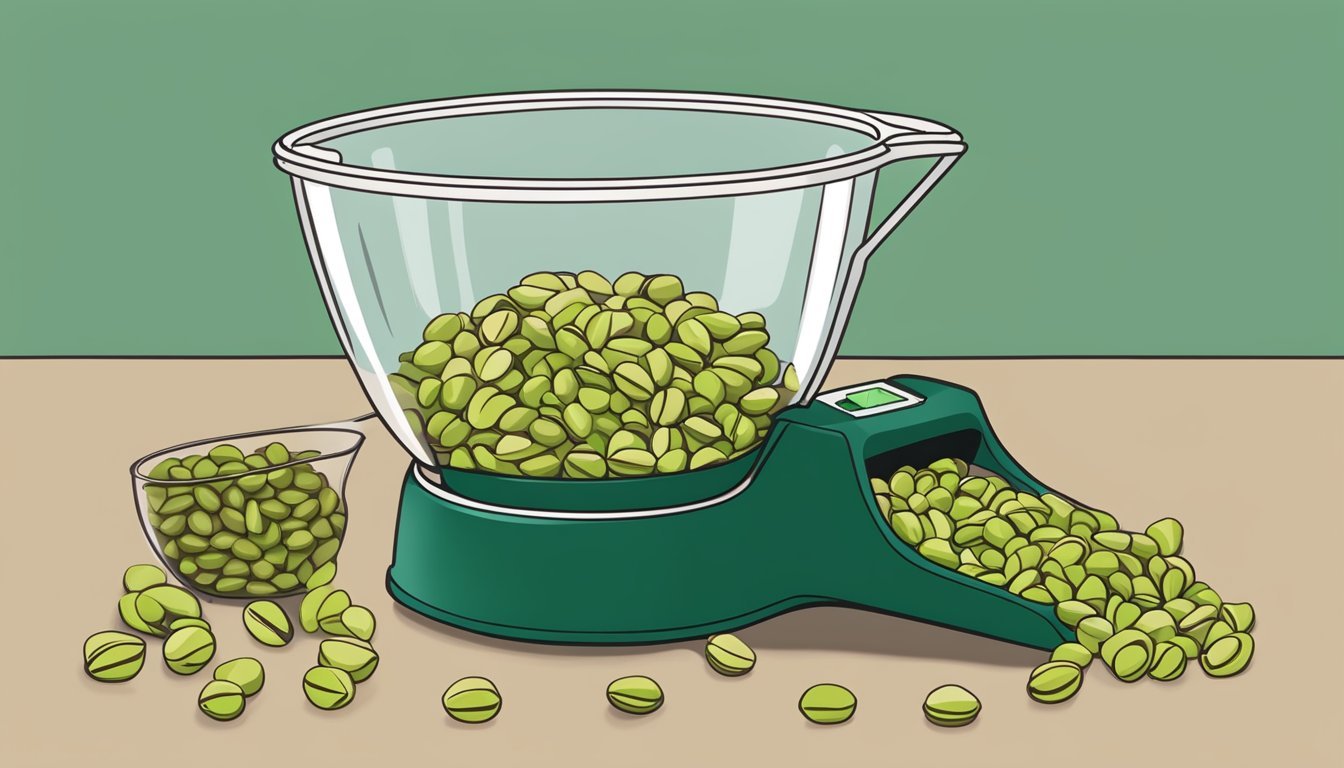How Many Cups in a Pound of Pistachios
Your Ultimate Measurement Guide
When it comes to cooking and baking, converting weights to volumes is an essential kitchen skill. Particularly for pistachios, which are often used in recipes for their rich flavor and crunchy texture, it's important to understand how weight translates into volume. A pound of pistachios can equate to different cup measurements depending on whether the nuts (What wine goes well with nuts?) are shelled or unshelled.
For shelled pistachios, a pound typically translates to about 3.63 US cups. These measures are approximate, as the size and fullness of the pistachio kernels can cause some variation. In contrast, if one is measuring in-shell pistachios, a pound is roughly equivalent to 2 cups shelled. An ounce of in-shell pistachios is about 20 nuts, while a single cup of in-shell pistachios equates to half a cup of nutmeats.
It's also important to consider that pistachios in their shells will weigh more than shelled pistachios due to the additional weight of the shells. Thus, if a recipe calls for a pound of pistachios and only shelled pistachios are available, one must account for the absence of shell weight when measuring out the appropriate volume of nutmeats.
Nutritional Profile of Pistachios
Pistachios are a nutrient-dense snack that offers a rich blend of macronutrients and essential vitamins and minerals. They are particularly known for their healthy fats, protein content, and fiber.
Macronutrients Breakdown
Calories: An ounce of pistachios, which is about 49 kernels, contains approximately 159 calories.
Fat: This same serving size has 12.8 grams of fat, which includes:
Saturated Fat: A minimal amount, contributing to the overall fat content.
Monounsaturated Fat: Pistachios contain a substantial proportion of monounsaturated fats, which are considered heart-healthy.
Protein: With 5.73 grams per ounce, pistachios are a good source of plant-based protein.
Carbohydrates: There are 7.71 grams of carbohydrates in an ounce of pistachios.
Fiber: Each ounce also delivers about 3 grams of dietary fiber, aiding digestion and satiety.
Vitamins and Minerals Content
Pistachios are a treasure trove of essential vitamins and minerals:
Potassium: They contribute to electrolyte balance and proper muscle function.
Vitamin B6: Pistachios are a significant source of Vitamin B6, which is vital for various bodily functions including metabolism and immune system health.
Antioxidants: They are rich in carotenoids, the pigments that give pistachios their unique green hue, which serve as antioxidants.
Pistachios balance a high nutritional density with a satisfying crunch, making them a smart choice for a healthy diet.
Pistachios and Health
Pistachios offer a spectrum of health benefits, primarily due to their nutrient composition which impacts heart health, blood sugar regulation, and chronic disease management.
Heart Health Benefits
Pistachios contribute to heart health by providing healthy fats and being a good source of antioxidants. Regular consumption of these nuts has been associated with improvements in blood pressure and cholesterol levels, crucial factors in reducing the risk of heart disease. Specifically, they contain monounsaturated and polyunsaturated fatty acids, which may help reduce the levels of LDL cholesterol (often referred to as "bad" cholesterol) when they replace saturated fats in the diet.
Glycemic Index Importance
The glycemic index (GI) of a food signifies its effect on blood sugar levels. Foods with a low GI are important for blood sugar control, making pistachios an excellent choice for individuals with diabetes or those looking to manage their blood sugar levels. Due to their low GI, pistachios can help temper the rise in blood sugar when consumed with other higher-carbohydrate foods.
Dietary Role in Chronic Diseases
Pistachios may play a supportive role in the diet of individuals facing chronic diseases. They are not only a healthy snack option due to their fiber content, which supports digestive health, but their bioactive compounds like antioxidants and polyphenols could contribute to cancer prevention. Furthermore, the presence of these nutrients help in the management of diabetes by improving the body's ability to regulate blood sugar.
Using Pistachios in Cooking
Pistachios add a nutty flavor and crunchy texture to various dishes, and when measured properly, they contribute significantly to the dish's nutritional value.
Pistachios in Salads and Desserts
Shelled pistachios are an excellent addition to both salads and desserts, providing a satisfying crunch and a pop of green color. When incorporating them into salads, chefs often use the following measurements:
Whole pistachios: 1/4 cup for a hint of flavor and texture
Chopped pistachios: 1/3 cup for a more pronounced presence
For desserts, the pistachio can be both a main ingredient or an accent. Whether sprinkled atop a sophisticated cake or blended into a fine paste for use in pastries, the measurement often depends on the desired pistachio intensity.
Pistachio kernels: Up to 1 cup in finely chopped form is used in dessert recipes where the nut's flavor should stand out.
Choosing Pistachios for Baking
When baking, the choice of pistachio—raw, roasted, shelled, or unshelled—affects the end product's flavor and texture. Shelled pistachios are commonly used due to the convenience they offer. For baking, precise measurements are crucial:
Unshelled pistachios: Not typically used in baking due to the extra step of shelling required.
Shelled pistachios: 1 pound is equivalent to 3.63 cups, making it easier to measure out large quantities.
Bakers value pistachios for their rich, buttery taste and often pair them with ingredients like chocolate or fruit to enhance their natural flavor. When selecting pistachios for baking, one should choose unsalted and possibly untoasted varieties to maintain control over the dessert's final taste profile.
Measuring Pistachios
In cooking and baking, ensuring proper measurement of pistachios is essential for recipe accuracy. This section details the conversions between cups and pounds, as well as how to convert between shelled and unshelled pistachios, providing a clear understanding of the volume-to-mass relationship and the effect of the pistachio's form on its measurement.
Cups to Pounds Conversion
When dealing with pistachios in recipes, cooks may find the need to convert weight to volume or vice versa. One pound of shelled pistachios typically equates to about 3.75 to 4 US cups. To visualize the conversions:
0.1 pound of pistachios: approx. 0.36–0.40 US cups
0.5 pound of pistachios: approx. 1.87–2.00 US cups
1 pound of pistachios: approx. 3.75–4.00 US cups
The exact conversion may vary depending on whether the pistachios are whole, chopped, sliced, or crushed, as the smaller pieces will occupy less space than whole kernels.
Converting Shelled to Unshelled Pistachios
The shells of pistachios add significant volume without contributing to the edible portion's mass measurement. The conversion from in-shell measurements to shelled pistachio nuts (nutmeats) is important to ensure recipes are followed correctly.
1 pound in-shell pistachios: yields about 2 US cups of shelled pistachios
1 ounce in-shell pistachios: yields about a handful, or 20 nuts approximately
1 cup in-shell pistachios: converts to about 0.5 cup of nutmeats
It is worth noting that there is a distinction between weight and volume: while weight (mass) is measured in pounds, ounces, grams, and milligrams, volume is measured in cups. The form of pistachios—raw, chopped, sliced, or crushed—can alter their volume, thus affecting how many cups they equate to when measured by weight.
Pistachio Varieties and Alternatives
Pistachios come in different varieties and there are alternatives worth considering for those who have pistachio-specific allergies or prefer a different taste profile.
Comparative Analysis with Other Nuts
Pistachios are often compared to other nuts for their unique flavor and nutritional profile. Almonds can be used as a substitute in recipes, as they have a similar texture and are also used in flour form. Cashews, with their creamy texture, often replace pistachios in vegan recipes to achieve a comparable richness. Pine nuts and hazelnuts, while distinct, share the versatile nature of pistachios in both savory and sweet dishes.
For a practical comparison:
Nut Type Texture Flavor Profile Common Uses Almonds Firm Mild, slightly sweet Snacks, flour, milks Cashews Creamy Buttery, sweet Vegan cheeses, cream sauces Pine nuts Soft Delicate, sweet Pesto, garnishes Hazelnuts Crunchy Rich, nutty Spreads, desserts
In terms of nutritional content, these nuts offer proteins, fats, vitamins, and minerals, but the specific nutritional makeup varies, having implications for dietary considerations.
Allergic Considerations for Nut Consumption
For individuals with nut allergies, the consumption of pistachios and their alternatives requires caution. Nut allergies can range from mild sensitivity to anaphylactic shock, a severe allergic reaction that requires immediate medical attention. It should be noted that while peanuts are legumes, many people with tree nut allergies also have peanut allergies, mandating vigilance with all types of nuts.
Here is a brief outline of allergic considerations:
Almonds, cashews, hazelnuts, and pine nuts are tree nuts, like pistachios, and cross-reactivity is possible.
Peanuts are often processed in facilities that handle tree nuts, leading to possible contamination.
Anyone with a history of nut allergies should consult a healthcare provider before introducing new nuts into their diet.
Label reading is essential to avoid accidental exposure to allergens.
Selecting a nut variety or alternative when dealing with allergies emphasizes the importance of understanding the respective allergen profiles of each nut to maintain safety and well-being.
Buying and Storing Pistachios
When purchasing pistachios, one needs to consider factors such as size and freshness, while proper storage hinges on maintaining the right temperature and humidity levels.
Selecting Quality Pistachios
When buying pistachios, shoppers should look for nuts that are mainly open. Closed shells often indicate immaturity. The size of the nut should be consistent, a sign of quality and good sorting practices by the producer. The color of the pistachio shell should be a natural, beige hue, while the nutmeat itself should have a vibrant green to yellow-green color. Fresh pistachios have a mild, nutty aroma and should not smell sour or rancid.
Optimal Storage Conditions
Pistachios are best preserved at a temperature range of 32°F to 50°F (0°C to 10°C) to maintain freshness. Keep them away from heat sources, such as direct sunlight, as temperatures above 70°F (21°C) can hasten the rancidity of oils in the pistachios. The ideal humidity level for storing pistachios is in a low-humidity environment to prevent softening and loss of crunchiness. Storing pistachios in an airtight container in a cool and dark place extends their shelf life. In-shell pistachios can be stored in the freezer, where they remain flavorful for up to two years. However, shelled pistachios have a shorter freezer shelf life and should be consumed within a year. When using frozen pistachios, one must allow the package to thaw to room temperature before opening it to prevent condensation, which can affect texture and flavor.
Understanding Food Conversions
Food conversion is a critical process in cooking and baking, involving the translation of weight to volume measurements and vice versa. It ensures that ingredients are measured accurately, which is essential for the desired outcome of a recipe.
Weight to Volume Conversions
When converting from weight to volume, one must understand that the density of the substance plays a pivotal role. For pistachios, a common conversion might state that 1 pound of unshelled pistachios is equivalent to approximately 2 cups shelled. To be more specific:
1 pound of pistachios = 3.63 US cups (approximately)
This relationship indicates that the actual volume may vary slightly depending on factors such as the size of the nuts and how well they are packed into a measuring cup.
Weight (pounds) Volume (cups) 1 3.63 0.5 1.815
When utilizing a converter, a user should enter the weight in grams (g) or ounces (oz) to retrieve the corresponding volume in liters (L) or milliliters (ml), using the specific density of pistachios.
Accuracy and Common Mistakes
Measuring ingredients by weight using scales is generally more accurate than using volume measurements because it accounts for the varying densities of substances.
Common mistakes that lead to inaccuracy include:
Not calibrating kitchen scales properly, resulting in an incorrect mass measurement.
Assuming all substances have the same density, which can lead to using the wrong volume unit.
An important disclaimer for anyone following a recipe is that there might be slight variations in conversions provided:
An ounce of pistachios does not necessarily convert to the same volume as an ounce of another substance.
Finally, when measuring foods, especially for baking, it’s crucial to be as precise as possible to avoid error. An accurate food conversion from weight to volume and vice versa can make the difference between success and failure in a culinary endeavor.
Pistachio Consumption Guidelines
When incorporating pistachios into one's diet, it is important to consider the recommended daily serving and be aware of potential risks and precautions. These guidelines can help consumers enjoy pistachios as a healthy snack that fits into a balanced diet.
Recommended Daily Serving
Pistachios are a nutrient-dense snack, rich in vitamins, minerals, and phytonutrients such as lutein and zeaxanthin which are beneficial for eye health. They contain heart-healthy fats and can contribute to the fat content recommended within the Mediterranean diet. A daily serving of pistachios is about 1 ounce (28.35 grams), which approximately equals 49 pistachio nuts. This serving size provides essential nutrients including copper, phosphorus, and phytosterol, along with a mix of polyphenols which may have antioxidant properties.
Nutritional Facts per 1 ounce (28.35 grams) of shelled pistachios:
Calories: 159 kcal
Fat: 12.85g
Carbohydrates (including dietary fiber): 7.93g
Protein: 5.72g
Tip: Measure out a serving instead of eating directly from a large container to avoid overconsumption.
Risks and Precautions
Pistachios generally have a low glycemic index and can be beneficial in managing blood sugar levels when consumed as part of a balanced diet. However, individuals with allergies to tree nuts should avoid pistachios. Additionally, salted pistachios can increase sodium intake significantly, so unsalted varieties are preferable, especially for those monitoring their blood pressure. Overconsumption of pistachios, like any high-fat food, may lead to excess calorie intake and weight gain. It is always best to enjoy pistachios in moderation and within the context of one’s overall diet.
Precautions:
Check for possible tree nut allergies.
Choose unsalted options to control sodium intake.
Be mindful of portion sizes to maintain a balanced diet.
The Role of Pistachios in Diets
Pistachios offer significant nutritional value as a versatile component of various diets, notable for their protein, fiber, and healthy fat content. These green nuts play a role in the Mediterranean diet and are suitable for diabetes and heart-healthy diets due to their impact on blood sugar levels.
Pistachios in the Mediterranean Diet
The Mediterranean diet emphasizes plant-based foods, lean proteins, and healthy fats. Pistachios fit seamlessly within this dietary pattern.
Nutritional Profile:
Calories: Moderate
Fat: Predominantly monounsaturated and polyunsaturated
Protein: High
Fiber: High
In the context of the Mediterranean diet, pistachios contribute to satiety and nutrient intake while supporting a balance of macronutrients. They can enhance the flavor and nutritional value of meals, whether used in salads, as a snack, or as a crust for fish and poultry.
Inclusion in Diabetic and Heart-Healthy Diets
Pistachios have a low glycemic index, meaning they have a minor effect on blood sugar when consumed. This property makes them an excellent inclusion in diets for individuals with diabetes, as they aid in managing blood sugar levels.
Benefits for Diabetic and Heart-Healthy Diets:
Blood Sugar: Their fiber content helps prevent blood sugar spikes.
Heart Health: Pistachios are rich in antioxidants and contain phytosterols that contribute to the reduction of bad cholesterol levels, thus supporting cardiovascular health.
Cancer: While not a primary consideration in these diets, the antioxidants in pistachios also contribute to cancer prevention efforts.
In heart-healthy diets, pistachios' unsaturated fats play a pivotal role in improving lipid profiles and reducing the risk of heart disease. It is important for individuals with diabetes or at risk of heart disease to incorporate pistachios into their diets in mindful portions to enjoy their full range of health benefits.

